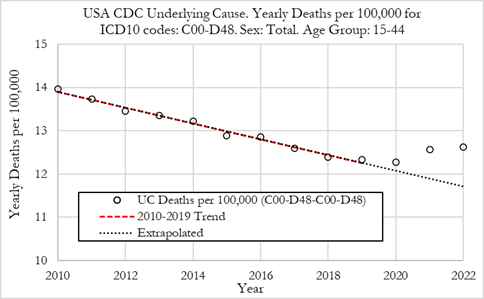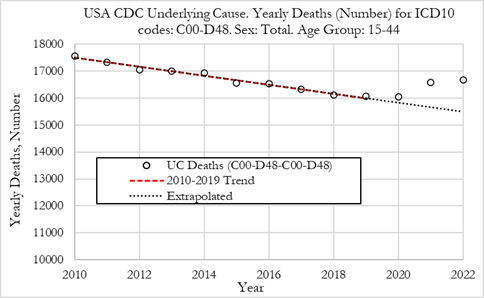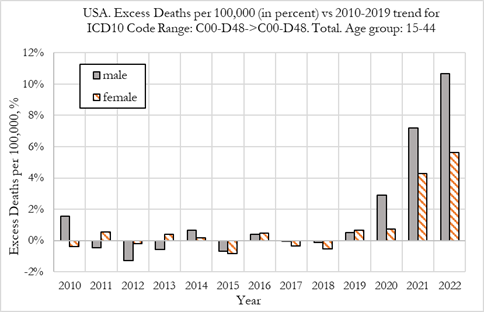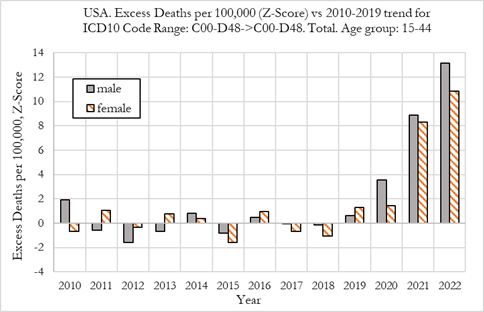Summary/Abstract
In this study we investigate trends in death rates from neoplasms (ICD-10 codes C00-D48) in the USA using crude data from the CDC (Centers for Disease Control and Prevention). We limit our investigation to individuals aged 15 to 44 and for the period of 2010 to 2022. We investigate both trends in neoplasms where these appear on multiple causes (MC) of death, or as the underlying cause (UC), as well as the trends in the ratio of multiple cause to underlying cause death rates. Using different metrics, we compare mortality trends due to neoplasms before the COVID-19 pandemic with the pandemic period.
We show a rise in excess mortality from neoplasms reported as underlying cause of death, which started in 2020 (1.7%) and accelerated substantially in 2021 (5.6%) and 2022 (7.9%). The increase in excess mortality in both 2021 (Z-score of 11.8) and 2022 (Z-score of 16.5) are highly statistically significant (extreme events). When looking at neoplasm death reported as one of multiple causes of death, we observe a similar trend with excess mortality of 3.3% (Z-score of 5.1) in 2020, 7.9% (Z-score of 12.1) in 2021, and 9.8% (Z-score of 15.0) in 2022, which were also highly statistically significant. The results indicate that from 2021 onwards, a novel phenomenon leading to increased neoplasm deaths appears to be present in individuals aged 15 to 44 in the US.
The greater rise in deaths due to neoplasms in multiple causes compared to underlying cause indicates that some deaths from neoplasms are being brought forward by other causes. The rise in cancer-death rates as underlying cause might be the result of an unexpected rise in the incidence of rapidly growing fatal cancers and/or a reduction in survival in existing cancer cases. Further stratification is underway, for example by age and cancer type to understand these trends and their relationship to pandemic related factors such as access to or utilisation of cancer screening and treatment, changes in health-related behaviours such as exercise or smoking, exposure to COVID-19 disease or COVID-19 vaccines.
Trends in Death Rates from Neoplasms for Ages 15-44
In this section we analyse the trend in yearly death rates for individuals aged 15 to 44 in the USA. In this analysis we use the 2010-2019 trend in deaths per 100,000 (death rates) as the baseline estimate for excess death rates. Excess death rates for the 2010-2019 period are in-sample while the rates for 2020, 2021, and 2022 are out of sample computations.
Trends in Death Rates from Neoplasms as Underlying Cause (UC) of Death
The Figure (left) below shows the death rate per 100,000 individuals for neoplasm deaths (ICD-10 codes C00 to D48) as underlying cause in the US, for the 15-44 age group of both sexes. The Figure on the right shows the absolute number of deaths.
Summary:
-
The death rate trended downwards from 2010 to 2019 with a significant downward slope and a reduction of 12.1% from 14 per 100,000 in 2010 to around 12.3 per 100,000 in 2019.
-
The death rate dropped slightly in 2020 to about 12.2 per 100,000 and then rose to 12.6 per 100,000 in 2021 and again to about 12.7 per 100,000, similar to that observed in 2017.
-
The absolute number of deaths with neoplasms as underlying cause were about 16,000 in both 2019 and 2020 rising to about 16,580 and 16,670 deaths in 2021 and 2022 respectively.
Analysis of Excess Death Rates from Neoplasms for Ages 15-44, Both Sexes.
In this section we investigate the trends in excess death rates from neoplasms as underlying cause in the US, for the 15 to 44 age group from 2010 to 2022. We also show the excess all-cause deaths for comparison. The figure on the left refers to relative deviations from the 2010-2019 trend, while the figure on the right shows the Z-score (signal strength) for the deviations from trend.
Excess UC Death Rates from Neoplasms, 15-44
The excess death rates from neoplasms as the underlying cause (UC) were 1.7% in 2020, rose to 5.6% in 2021, and 7.9% in 2022. By comparison, the excess mortality for all-cause deaths was 19.9% in 2020, 33.8% in 2021, and 18.2% in 2022. Noteworthy is that the drop in excess mortality for all-cause deaths from 2021 to 2022 was not mirrored in a drop in neoplasm deaths. In fact, the opposite occurred, with an increase in excess deaths due to neoplasms as the underlying cause.
In terms of statistical significance of the excess deaths, we observe from the Figure (right) that for all-cause deaths, the Z-score in 2020 was 6.5, which is a very strong signal. In 2021, the Z-score was 11.0 which is an extreme signal. In 2022 the Z-score dropped to 5.9, which still indicates that the excess deaths are a statistically significant deviation from the 2010-2019 trend.
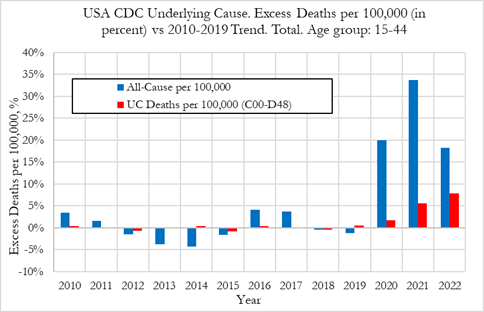
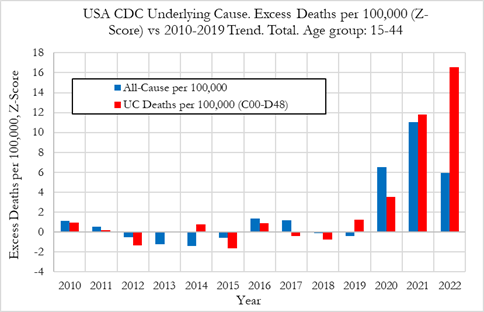
Summary:
-
Our analysis shows a statistically significant excess UC death rate from neoplasms starting in 2021 and increasing further in 2022.
Excess MC Death Rates from Neoplasms, 15-44
In the Figure (left) below we observe that the excess MC death rates from neoplasms were 3.3% in 2020, then rose to 7.9% in 2021, and 9.8% in 2022. By comparison, the excess UC death rates were 1.7% in 2020, 5.6% in 2021, and 7.9% in 2022. Of note is that the excess mortality for MC deaths from cancer was greater than for UC deaths in all three pandemic years, particularly in 2020.
In terms of statistical significance of the excess deaths, we observe from Figure (right) that for all-cause deaths, the Z-score in 2020 was 6.5, which is a very strong signal. In 2021, the Z-score was 11.0 which is an extreme signal. In 2022 the Z-score dropped to 5.9, which still indicates that the excess deaths are a statistically significant deviation from the 2010-2019 trend.
MC deaths rates need to be taken with caution as they refer to death rates for a given disease where it is either the underlying cause or a contributing factor towards death. Some diseases, such as respiratory diseases, are mostly attributed as contributing factors for death while other causes are the underlying cause. This means that MC death rates from respiratory diseases could amount to several times the UC death rate. On the other hand, by analysing both MC death rates and UC death rates, we can have a better understanding of the underlying phenomena that lead to death.
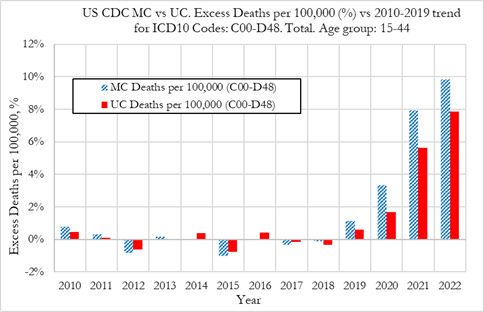
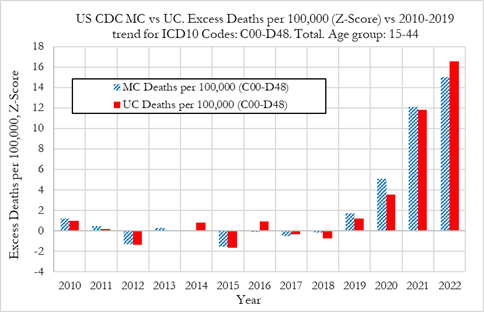
Summary:
-
Our analysis shows a statistically significant excess MC death rate from neoplasms starting in 2020 and increasing further in 2021 and 2022.
Analysis of Excess Death Rates from Neoplasms for Males and Females, Aged 15-44
We now compare excess deaths rates from neoplasms for males and females aged 15-44, as shown in the Figure below.
When comparing excess UC death rates attributed to neoplasms for males and females we observe that in 2020, while females had no significant excess mortality, males experienced about 3% excess mortality, with a Z-score of about 3.5 indicating a statistically significant deviation from trend.
Summary:
-
In 2021 excess UC death rates from neoplasms for males was 7.2% while only 4.2% for females, both having Z-scores close to 8, indicating very high statistical significance. Males experienced about a 70% higher excess mortality from neoplasms compared with females in 2021.
-
In 2022 excess UC death rates from neoplasms for males was about 10.7%, almost double that of 5.8% for females, both having Z-scores above 10, indicating extreme occurrences.
Conclusions
-
In our study we analyse trends in death rates from neoplasms in individuals aged 15-44 in the USA. We compare excess death rates for neoplasms where they are classified as the underlying cause of death (UC) or with cancers as multiple cause of death (MC) of death, either underlying cause or contributing cause.
-
When analysing UC death rates from neoplasms, our computations show that the excess death rates from neoplasms for the 15-44 age group were 1.7% in 2020, 5.6% in 2021, and 7.9% in 2022. Even though the deviation from trend was small, the excess death rate in 2020 was statistically significant with a Z-score of 3.5. The excess UC death rates in 2021 and 2022 can be considered extreme events with respective Z-scores of 11.8 and 16.5.
-
When analysing MC death rates we found that the excess death rate from neoplasms was 3.3% in 2020, then rose to 7.9% in 2021, and 9.8% in 2022. The excess death rate in 2020 was highly statistically significant with a Z-score of 5.1. The excess MC death rates in 2021 and 2022 can be considered extreme events with respective Z-scores of 12.1 and 15.0.
-
The rise in MC cancer deaths in 2020 may be due at least in part to other causes such as COVID-19 or the effect of the lockdowns, which may have limited access to diagnosis or treatment. In 2021 and 2022 we observe larger rises in deviations from trend in MC death rates from neoplasms, compared to deviations from trend in UC death rates.
-
If the initial rise in cancer-related deaths in 2020 is explained by a pull-forward effect, it was not followed by an expected compensatory period of negative excess deaths, but by a continued rise in UC neoplasm death rates in 2021 and 2022. Thus, a different phenomenon may be occurring, overlapping in timescale, of increased incidence or severity of cancers.
Further work:
-
We are currently in the process of pursuing further investigations into this issue in more detail. In particular, cancer trends need to be further stratified by age gender and cancer type. Health disparities during the COVID-19 pandemic related to race and ethnicity may be particular sources of confounding. The relationship between cancer deaths as a multiple cause for other underlying causes must be dissected. Additionally, changes in incidence and survival statistics during the COVID-19 pandemic must be examined, when reliable data are available.
-
For a more detailed analysis please read our full paper (Link to paper).
